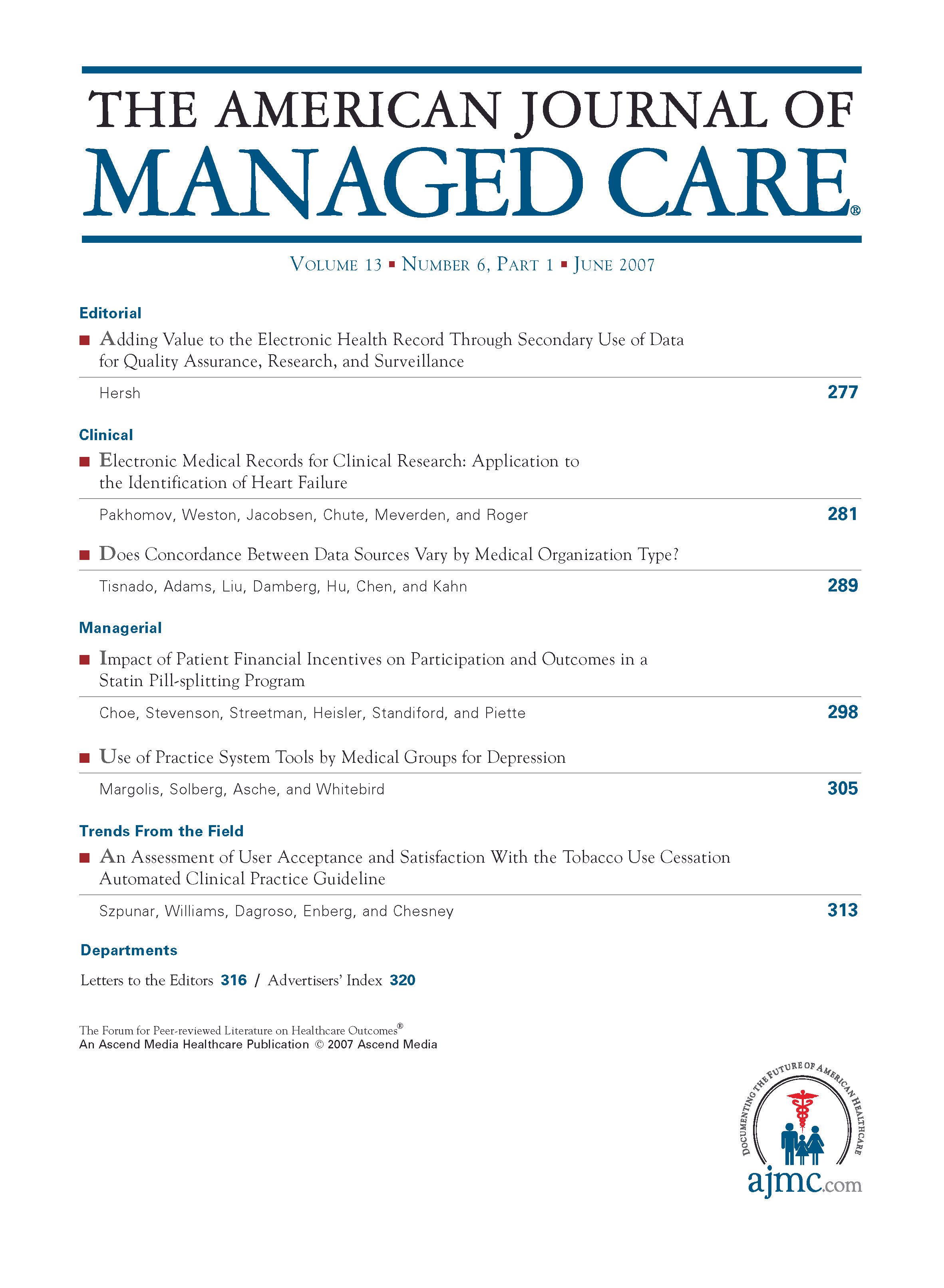- Center on Health Equity and Access
- Clinical
- Health Care Cost
- Health Care Delivery
- Insurance
- Policy
- Technology
- Value-Based Care
Adding Value to the Electronic Health Record Through Secondary Use of Data for Quality Assurance, Research, and Surveillance
A growing body of research is documenting the value of the electronic health record (EHR) for improving clinical care through alerts, reminders, and other forms of clinical decision support.1 The outcomes from these studies include enhanced error detection, improved adherence, and reduced cost.
However, the potential benefits of the EHR do not stop at direct patient care. There is increasing recognition that secondary use of the EHR and its data can provide additional value.2 Until now, there has been little research to substantiate these claims. The study reported in this issue by Pakhomov et al3 is a good step in this direction. These authors demonstrate that the text processing of the EHR narrative is effective in identifying patients with heart failure who may be candidates for clinical research. The text processing approach is more accurate than traditional coding from billing records and is available sooner. Furthermore, the authors developed both high-sensitivity and high-specificity approaches.
This research gives credence to the notion of secondary use of data for clinical research. Clinical research, of course, is only one such use. Secondary uses of data could include quality measurement, public health surveillance, and patient access to data about their illness. The American Medical Informatics Association (http://www.amia.org) recognizes the importance of secondary use of data and convened a summit in 2006 that resulted in a white paper laying the groundwork for policy, future research, and a taxonomy of uses.2
The work by Pakhomov and coworkers3 also supports the importance of the role of biomedical informatics in the growing push for clinical and translational research. This view is shared by the National Institutes of Health, the main funder of biomedical research in the United States, whose call for proposals to establish centers for clinical and translational research viewed biomedical informatics as a core competency of such centers. This initiative, the Clinical and Translational Science Award program, will benefit from research such as that described by Zerhouni.4
The potential benefits are enormous for improved secondary use of data, particularly their use in translational research. The benefits begin at the basic science level with in silico hypothesis testing in genomics, proteomics, and other fields (ie, systems biology).5 As the EHR develops and contains more data, it can represent the patient's "phenotype" and be associated with the increasing amount of genotype data we have about individuals.6 Other opportunities will exist from the personal level (eg, the Department of Health and Human Services Personalized Health Care Initiative [http://www.hhs.gov/myhealthcare/]) to the population level.7 Experts advocate that this will facilitate "rapid learning" in the healthcare system.8,9
There are challenges to this vision. On the clinical side, there are impediments associated with the cost and financing of EHRs, their synchronization with clinical work flow, and the myriad of issues regarding interoperability, standards, and terminology.10 On the research side, many academic medical centers face inadequate information technology infrastructure and a lack of integration with clinical systems data.11 In clinical and research settings, a well-trained workforce of informatics professionals is essential.12
The work by Pakhomov and colleagues3 should continue and be expanded. Of course, few medical centers have the advanced EHR infrastructure of the Mayo Clinic that was used in this study. Indeed, the success of this study drives home the growing concern that we need wider adoption of EHRs. This is just one more incentive for their use.
2. Safran C, Bloomrosen M, Hammond WE, et al. Toward a national framework for the secondary use of health data: an American Medical Informatics Association white paper. J Am Med Inform Assoc. 2007;14:1-9.
4. Zerhouni EA. Translational research: moving discovery to practice. Clin Pharmacol Ther. 2007;81:126-128.
6. Williams RW. Expression genetics and the phenotype revolution. Mamm Genome. 2007;17:496-502.
8. Etheredge LM. A rapid-learning health system. Health Aff (Millwood). 2007;26:w107-w118.
10. Hersh W. Health care information technology: progress and barriers. JAMA. 2004;292:2273-2274.
12. Hersh WR.Who are the informaticians? what we know and should know. J Am Med Inform Assoc. 2006;13:166-170.


